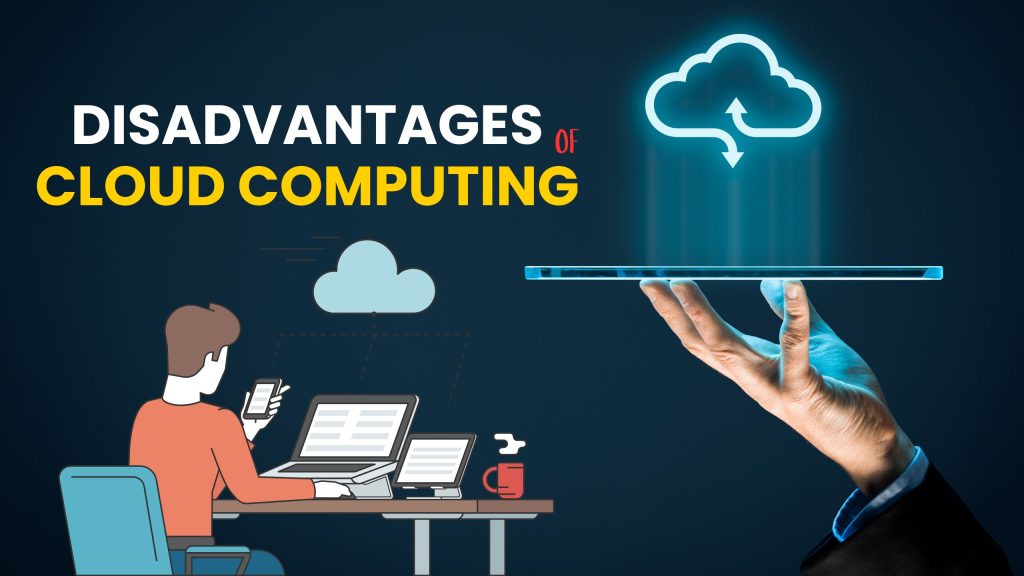Cloud computing offers many benefits, but it’s not without its drawbacks. While it provides flexibility, scalability, and cost savings, there are also important disadvantages to consider. From security risks and data privacy concerns to downtime and limited control, understanding the potential downsides of cloud computing is crucial before fully relying on it for your business or personal needs.
What is Cloud Computing?
Cloud computing refers to the on-demand delivery of computing resources such as servers, storage, databases, networking, and software over the internet. This technology allows businesses and individuals to access and store data remotely without the need to maintain physical IT infrastructure.
As data generation and online service demands continue to rise, relying solely on in-house computing servers has become increasingly challenging for companies. Cloud computing provides a scalable, cost-effective solution, enabling businesses to operate efficiently from anywhere with an internet connection.
Much like accessing your email via a web browser, cloud computing allows organizations to manage resources and applications remotely. These services are typically maintained by third-party providers, giving IT teams the flexibility to scale storage and computing power as needed—without upfront hardware investments or extensive system management.
Disadvantages of Cloud Computing
Want to deliver digital services of any kind, you’ll need to estimate all types of resources, not the least of which are CPU, memory, storage, and network connectivity. Which resources you choose for your delivery — cloud-based or local — is up to you. But you’ll definitely want to do your homework first. You’ll need to understand the pros and cons of cloud computing and how to contextualize any existing disadvantages.
Cloud computing has benefited many enterprises by reducing costs and enabling a focus on one’s core business competence, rather than IT and infrastructure issues. Despite the general hype on the subject across the IT world, there can be disadvantages of cloud computing, especially in smaller operations. Let’s take a look at the advantages and disadvantages of cloud computing and show you how to understand and contextualize any existing disadvantages.
So – if you’re wondering what are the disadvantages of cloud computing – you are in the right place. In this article, we’ll explore some of the key disadvantages of cloud computing and share tips and best practices that your teams can employ to address them.
Streamline this process by using a thorough, process-built approach to understanding cloud security, such as QA Self Paced Platform’s Security – Specialty Certification Preparation for AWS course.
Disadvantages of Cloud Computing Explained
1. Downtime
Downtime is often cited as one of the biggest cloud computing disadvantages. Since cloud computing systems are internet-based, service outages are always an unfortunate possibility and can occur for any reason.
Financial impact of service disruptions and outages is staggering. A recent survey conducted by Uptime Institute indicates that about 31% of businesses have experienced an IT service incident or outage that significantly impacted their operations within the past three years. On average, an outage and or slowdown can cost a business upwards of $100,000 an hour. Unfortunately, no organization is immune, especially when critical business processes cannot afford to be interrupted. In 2023 several companies and services were hit by outages, including IT Glue, Microsoft, Google Cloud and AWS (a major web services provider), Oracle, and Datadog.
Best practices for minimizing planned downtime in a cloud environment:
- Design services with high availability and disaster recovery in mind. Leverage the multi-availability zones provided by cloud vendors in your infrastructure.
- If your services have a low tolerance for failure, consider multi-region deployments with automated failover to ensure the best business continuity possible.
- Define and implement a disaster recovery plan in line with your business objectives that provide the lowest possible recovery time (RTO) and recovery point objectives (RPO).
- Consider implementing dedicated connectivity such as AWS Direct Connect, Azure ExpressRoute, or Google Cloud’s Dedicated Interconnect or Partner Interconnect. These services provide a dedicated network connection between you and the cloud service point of presence. This can reduce exposure to the risk of business interruption from the public internet.
- Read the fine print on your Service Level Agreement (SLA). Are you guaranteed 99.9% uptime or even better? That 0.1% downtime equals about 45 minutes per month or around eight hours per year.
2. Security and privacy
Although cloud service providers implement the best security standards and industry certifications, storing data and important files on external service providers always opens up risks. Any discussion involving data must address security and privacy, especially when it comes to managing sensitive data.
We must not forget what happened at Code Space and the hacking of their AWS EC2 console, which led to data deletion and the eventual shutdown of the company. Their dependence on remote cloud-based infrastructure meant taking on the risks of outsourcing everything.
Of course, any cloud computing service provider is expected to manage and safeguard the underlying hardware infrastructure of a deployment. However, your responsibilities lie in the realm of user access management, and it’s up to you to carefully weigh all the risk scenarios.
Though recent breaches of credit card data and user login credentials are still fresh in the minds of the public, steps have been taken to ensure the safety of data. One such example is the General Data Protection Rule (GDPR), which was recently enacted in the European Union to provide users more control over their data. Nonetheless, you still need to be aware of your responsibilities and follow best practices.
Best practices for minimizing security and privacy risks:
This is important: Understand the shared responsibility model of your cloud provider. You will still be liable for what occurs within your network and in your product.
- Implement security at every level of your deployment.
- Know who is supposed to have access to each resource and service, and limit access to least privilege. If an employee goes rogue and gains access to your deployment, you would want their impact to be over the smallest area as possible.
- Make sure your team’s skills are up to the task. The Top 10 Things Cybersecurity Professionals Need to Know is a great article to understand how to mitigate security and privacy concerns in the cloud.
- Take a risk-based approach to securing assets used in the cloud and extend security to the devices.
- Implement multi-factor authentication for all accounts accessing sensitive data or systems.
- Encryption, encryption, encryption. Turn on encryption wherever you can — easy wins are on object storage such as Amazon S3 or Azure Blob Storage where customer data often resides. The simple act of turning on encryption on S3 could have prevented the Capital One data breach in July 2019 that exposed 100 million users’ information.
3. Vulnerability to attack
Going on with the drawbacks of cloud computing, another one concerns vulnerability: in cloud computing, every component is online, which exposes potential vulnerabilities. Even the best teams suffer severe attacks and security breaches from time to time.
Since cloud computing is built as a public service, it’s easy to run before you learn to walk. After all, no one at a cloud vendor checks your administration skills before granting you an account: all it takes to get started is generally a valid credit card.
Best Practices to help you Reduce Cloud Attacks:
- Make security a core aspect of all IT operations.
- Keep ALL your teams up-to-date with cloud security best practices.
- Ensure security policies and procedures are regularly checked and reviewed.
- Proactively classify information and apply access control.
- Use cloud services such as AWS Inspector, AWS CloudWatch, AWS CloudTrail, and AWS Config to automate compliance controls.
- Prevent data exfiltration.
- Integrate prevention and response strategies into security operations.
- Discover rogue projects with audits.
- Remove password access from accounts that do not need to log in to services.
- Review and rotate access keys and credentials.
- Follow security blogs and announcements to be aware of known attacks.
- Apply security best practices for any open source software that you are using.
- Again, use encryption whenever and wherever possible.
These practices will help your organization monitor for the exposure and movement of critical data, defend crucial systems from attack and compromise, and authenticate access to infrastructure and data to protect against further risks.
4. Limited control and flexibility
Since the cloud infrastructure is entirely owned, managed, and monitored by the cloud service provider, it transfers minimal control over to the customer.
To varying degrees (depending on the particular service), cloud users may find they have less control over the function and execution of services within a cloud-hosted infrastructure. A cloud provider’s end-user license agreement (EULA) and management policies might impose limits on what customers can do with their deployments. Customers retain control of their applications, data, and services, but may not have the same level of control over their backend infrastructure.
Best practices for maintaining control and flexibility:
- Consider using a cloud service provider partner to help with implementing, running, and supporting cloud services.
- Understand your responsibilities and the responsibilities of the cloud vendor in the shared responsibility model to reduce the chance of omission or error.
- Make time to understand your cloud service provider’s basic level of support. Will this service level meet your support requirements? Most cloud service providers offer additional support tiers over and above the basic support for an additional cost.
- Make sure you understand the SLA concerning the infrastructure and services you’re going to use and how that will impact your agreements with your customers.
5. Vendor lock-in
Vendor lock-in is another perceived disadvantage of cloud computing. Easy switching between cloud services is a service that hasn’t yet completely evolved, and organizations may find it difficult to migrate their services from one vendor to another.
Differences between vendor platforms may create difficulties in migrating from one cloud platform to another, which could equate to additional costs and configuration complexities. Gaps or compromises made during migration could also expose your data to additional security and privacy vulnerabilities.
Best practices to decrease dependency:
- Design with cloud architecture best practices in mind. All cloud computing services provide the opportunity to improve availability and performance, decouple layers, and reduce performance bottlenecks. If you have built your services using cloud architecture best practices, you are less likely to have issues porting from one cloud platform to another.
- Properly understand what your vendors are selling to help avoid lock-in challenges.
- Employ a multi-cloud strategy to avoid vendor lock-in. While this may add both development and operational complexity to your deployments, it doesn’t have to be a deal breaker. Training can help prepare teams to architect and select best-fit services and technologies.
- Build in flexibility as a matter of strategy when designing applications to ensure portability now and in the future.
- Build your applications with services that offer cloud-first advantages, such as modularity and portability of microservices and code. Think containers and Kubernetes.
6. Cost concerns
The last one of the disadvantages of cloud computing concerns cost. Adopting cloud solutions on a small scale and for short-term projects can be perceived as being expensive. However, the most significant cloud computing benefit is in terms of IT cost savings.
Pay-as-you-go cloud services can provide more flexibility and lower hardware costs, but the overall price tag could end up being higher than you expected. Until you are sure of what will work best for you, it’s a good idea to experiment with a variety of offerings. You might also make use of the cost calculators made available by providers like Amazon Web Services and Google Cloud Platform.
Best practices to reduce costs:
- Try not to over provision your services, but rather look into using auto-scaling services.
- Ensure you have the option to scale DOWN as well as UP.
- Pre-pay and take advantage of reserved instances if you have a known minimum usage.
- Automate the process to start/stop your instances to save money when they are not being used.
- Create alerts to track cloud spending.
Disadvantages of cloud computing: Closing thoughts
Many organisations benefit from the agility, scale, and pay-per-use billing that cloud services offer. However, as with any infrastructure service, the suitability of cloud computing for your specific use case should be assessed in a risk-based evaluation. Build in time for research and planning to understand how the cloud will affect your business.
Benefits of Cloud Computing
1. Faster Time to Market
Cloud computing enables businesses to launch new applications and services quickly. Developers can spin up or retire instances in seconds, accelerating innovation and reducing delays caused by hardware limitations or lengthy procurement processes.
2. Scalability and Flexibility
With cloud computing, businesses can scale resources up or down based on demand without investing in physical infrastructure. This elasticity allows companies to handle peak workloads efficiently while reducing costs during low-usage periods.
3. Cost Savings
Cloud computing follows a pay-as-you-go model, meaning businesses only pay for the resources they use. This eliminates overprovisioning, reduces operational expenses, and allows IT teams to focus on strategic initiatives instead of infrastructure management.
4. Enhanced Collaboration
Cloud storage ensures seamless access to data from anywhere, on any device, as long as there is an internet connection. Teams can collaborate in real time, improving productivity and efficiency regardless of location.
5. Advanced Security
Reputable cloud providers implement robust security measures, including encryption, firewalls, and automatic updates. They employ top security experts and centralized management to offer better protection against cyber threats than most on-premise solutions.
6. Data Loss Prevention
Cloud providers offer built-in backup and disaster recovery features, ensuring data remains safe even in the event of hardware failures, cyberattacks, or accidental deletions. Storing data in the cloud reduces the risk of permanent data loss.
Why Switch to Cloud Computing?
Cloud computing offers undeniable advantages, making migration less of a question of “if” and more about “what” to migrate. Businesses today are turning to the cloud for its flexibility, reliability, enhanced performance, and cost efficiency.
Key benefits include:
✔ Lower IT Costs – Reduce capital expenditures on hardware and maintenance.
✔ Faster Innovation – Leverage AI, machine learning, and automation to stay competitive.
✔ Improved Productivity – Support remote teams with seamless access to data and applications.
✔ Operational Efficiency – Scale resources on demand without overprovisioning.
Migrating to the cloud doesn’t have to be an all-or-nothing approach. Many companies adopt a hybrid cloud strategy to extend their existing infrastructure while benefiting from the scalability and agility of the cloud. Whether for cost savings, performance, or innovation, cloud computing is the future of business operations.
FAQs
What are the main disadvantages of cloud computing?
The key drawbacks include security risks, downtime, dependency on internet connectivity, and potential hidden costs.
Is cloud computing secure?
While cloud providers offer security measures, data breaches, hacking, and compliance issues remain concerns.
What happens if the cloud service experiences downtime?
Downtime can disrupt business operations, leading to productivity loss and potential financial setbacks.
Are there hidden costs in cloud computing?
Yes, additional costs may arise from data transfer, storage expansion, and exceeding service limits.
How does internet dependency affect cloud computing?
A stable internet connection is required; any disruption can limit access to data and services.
Can cloud computing lead to vendor lock-in?
Yes, migrating data between cloud providers can be complex and costly, making businesses reliant on a single vendor.
Does cloud computing impact performance?
Performance can suffer due to latency issues, especially when handling large-scale data processing.
Are there compliance and legal issues with cloud computing?
Some industries have strict regulations that cloud providers may not fully comply with, leading to legal complications.
Can data loss occur in cloud computing?
While providers offer backups, data loss can still happen due to accidental deletions, cyberattacks, or provider failures.
How does cloud computing affect customization and control?
Businesses may have limited control over cloud environments, restricting software customization and specific configurations.




